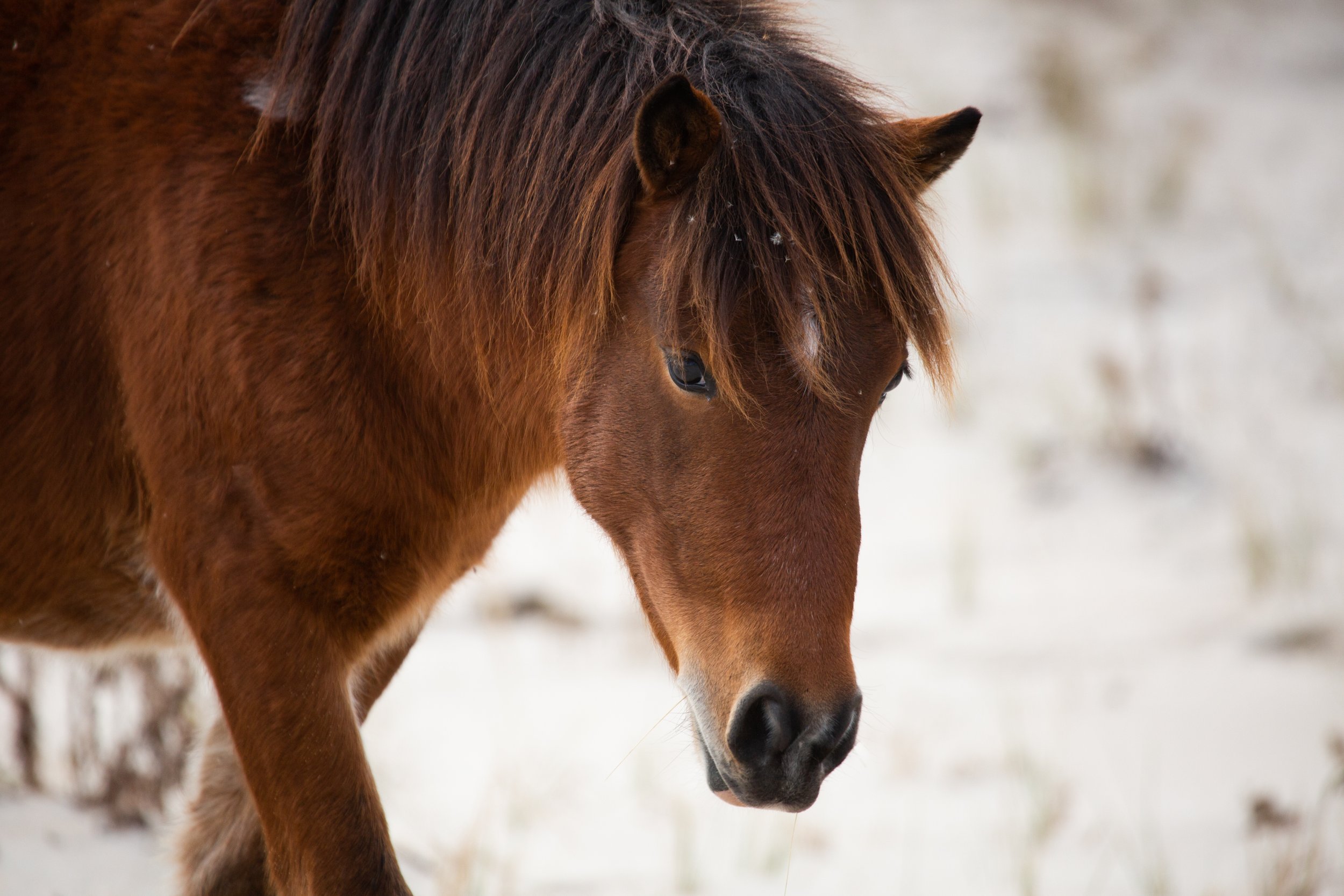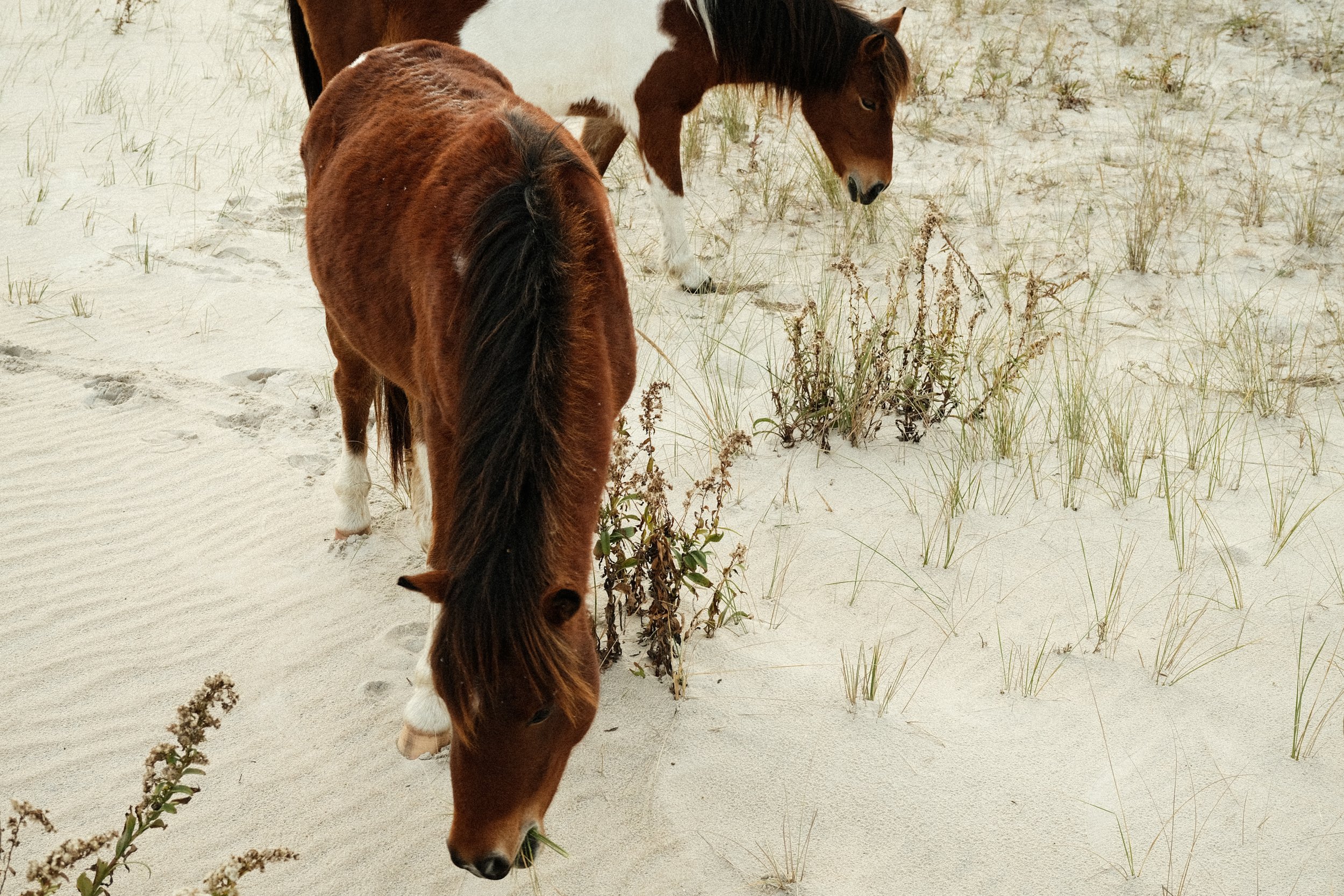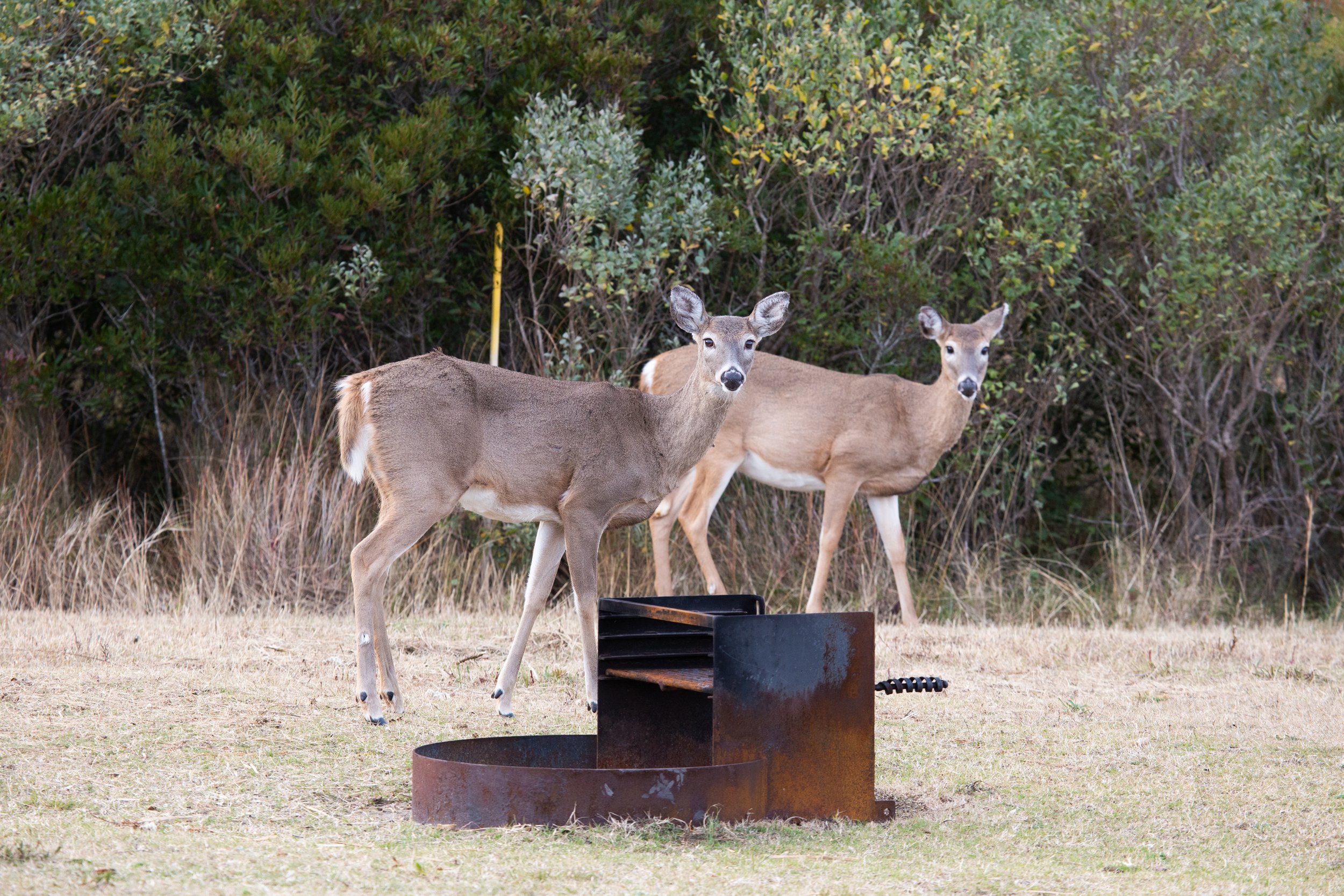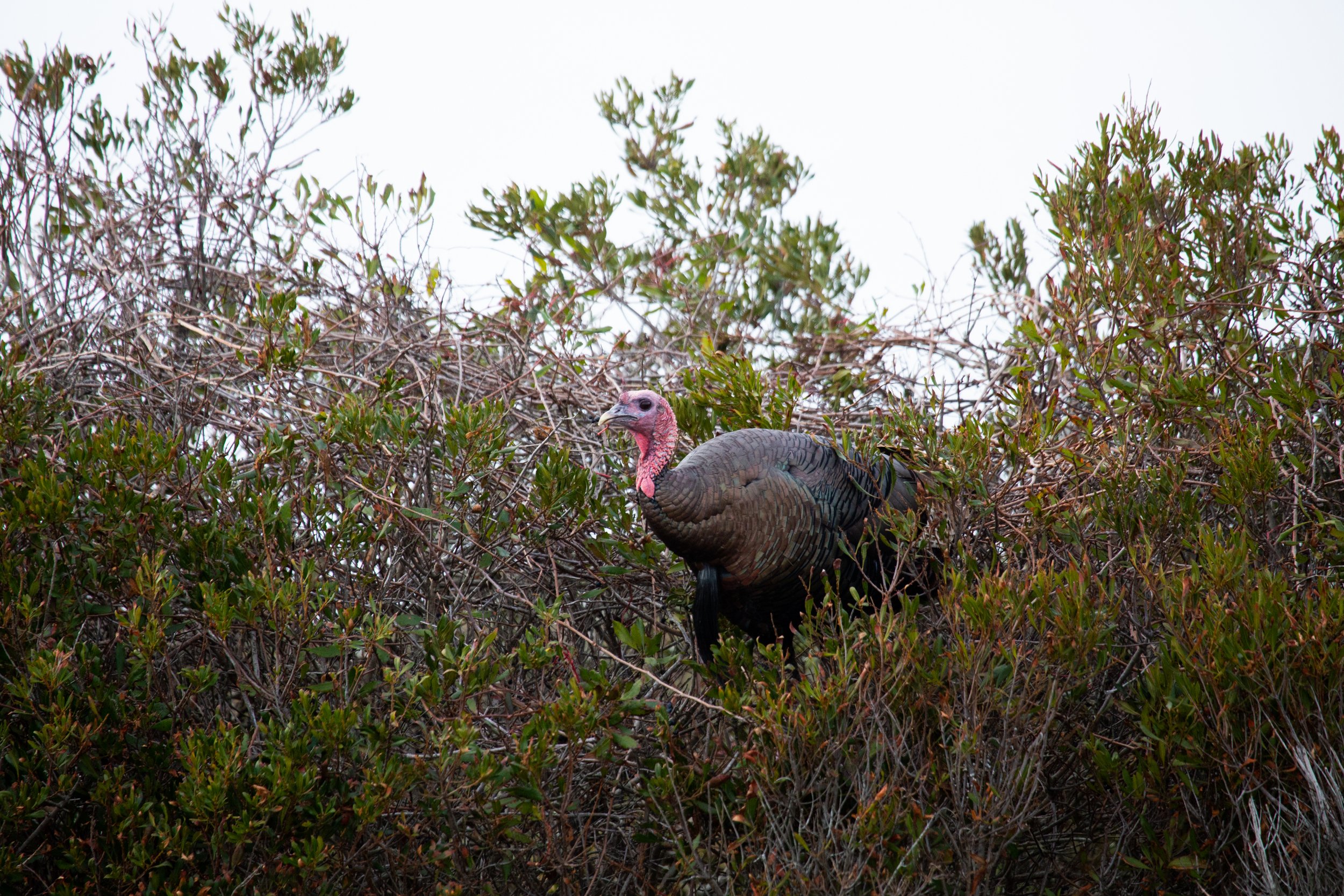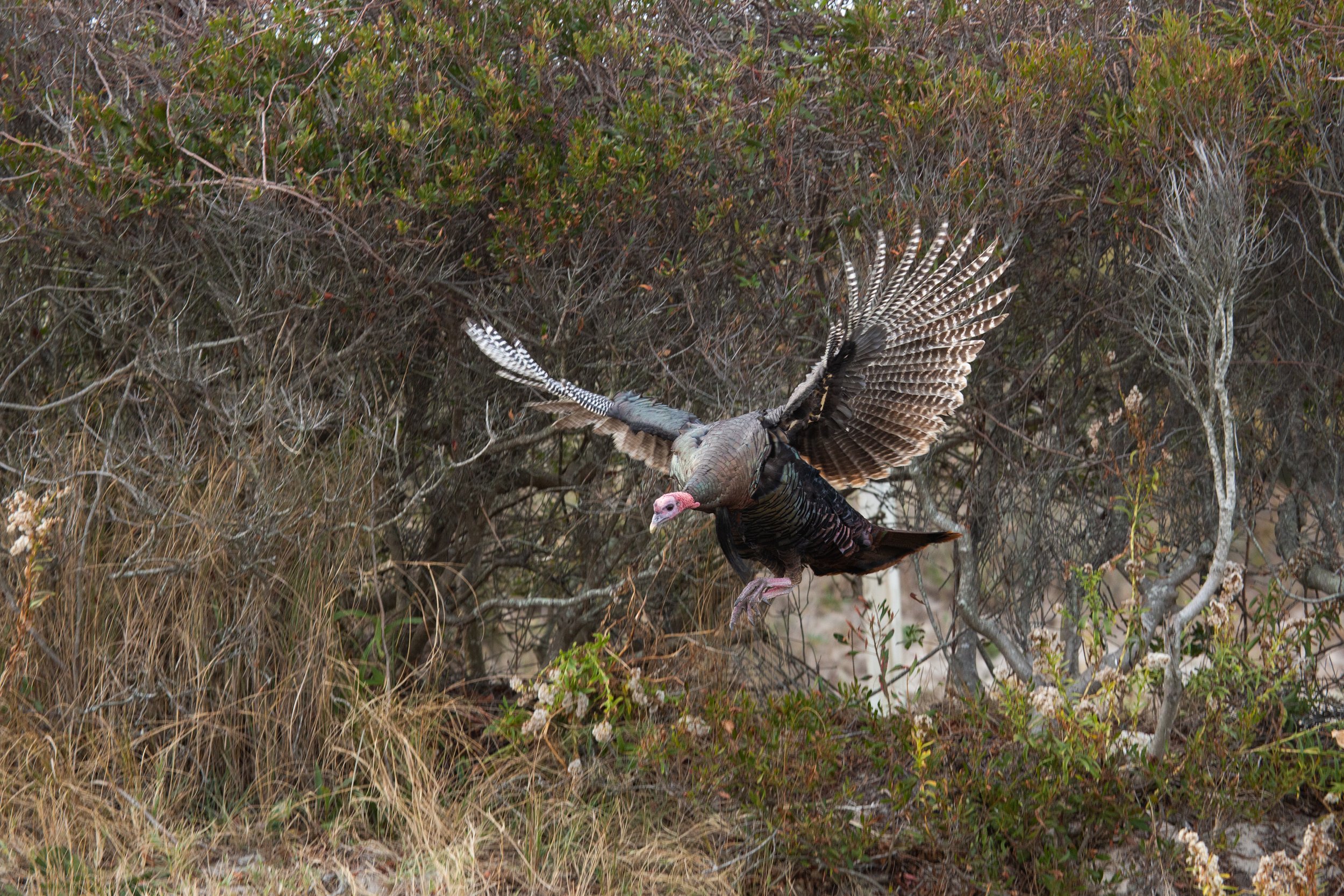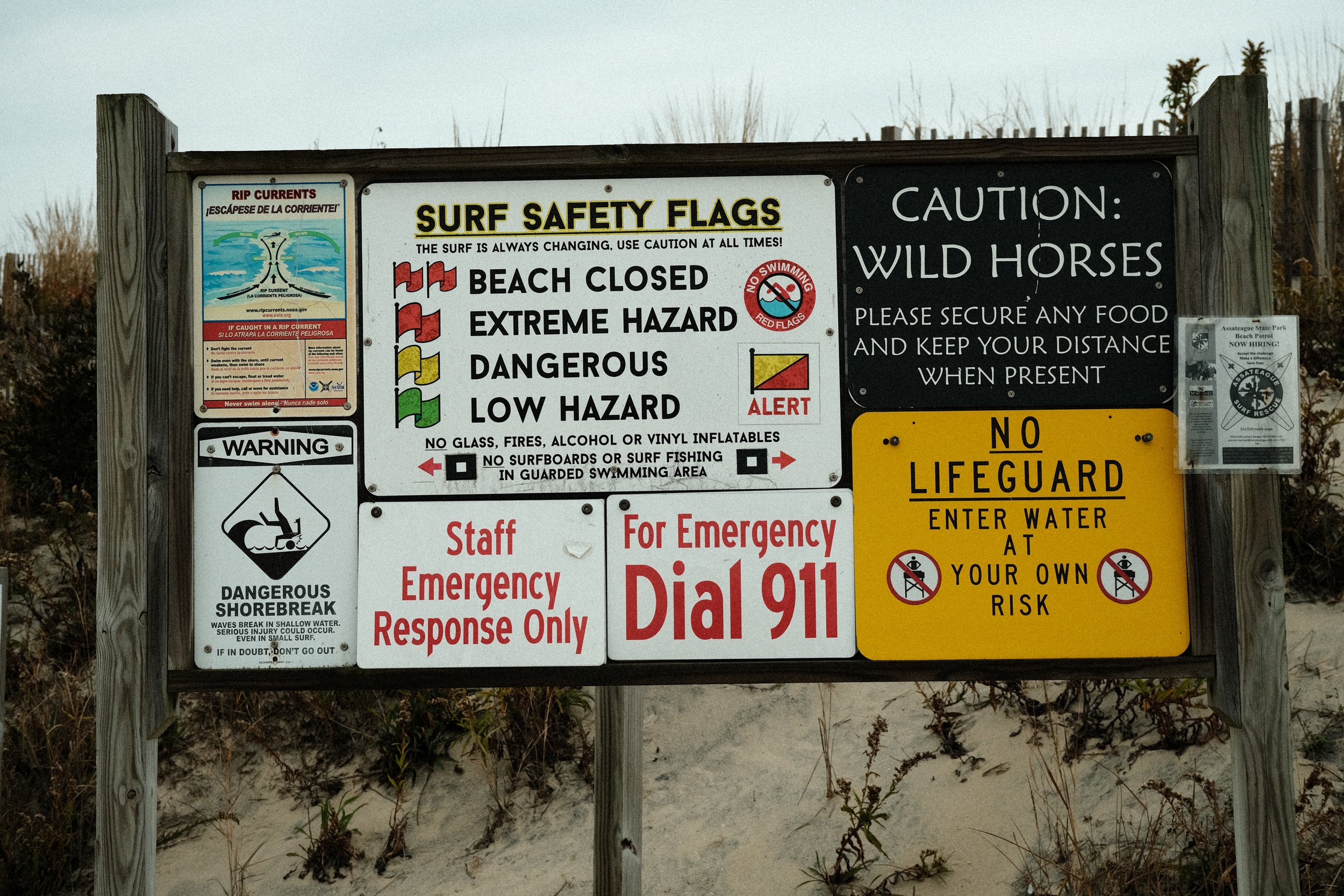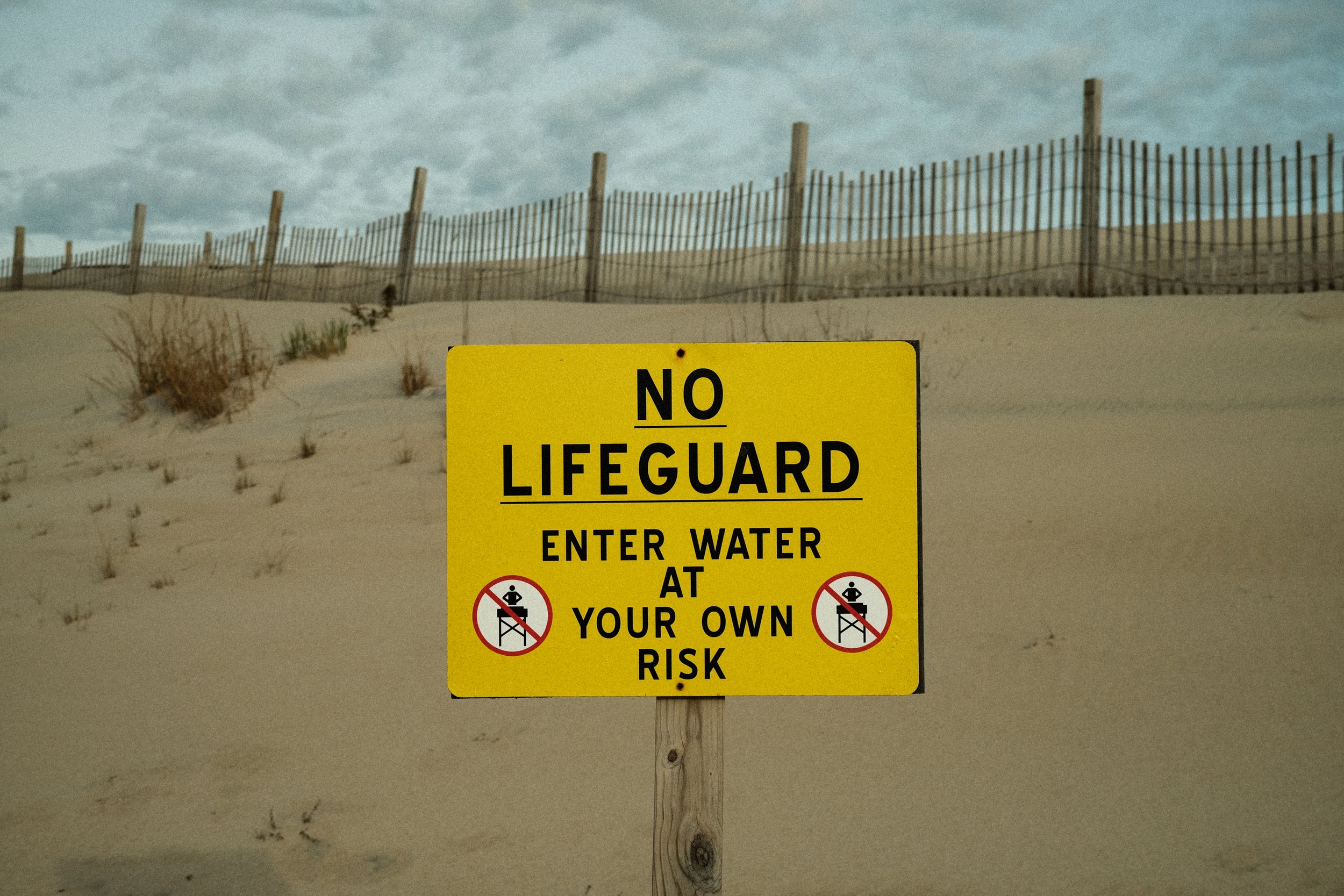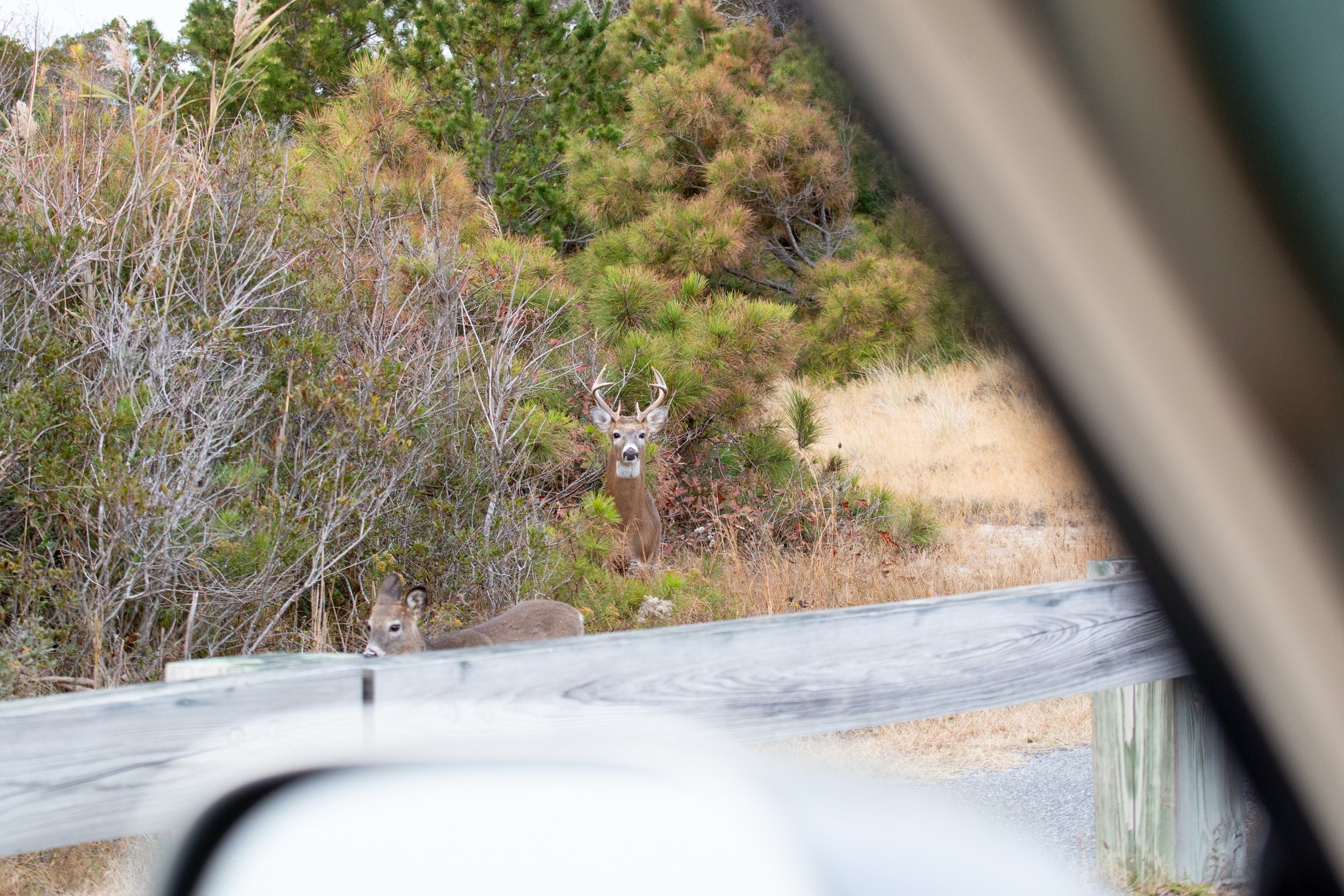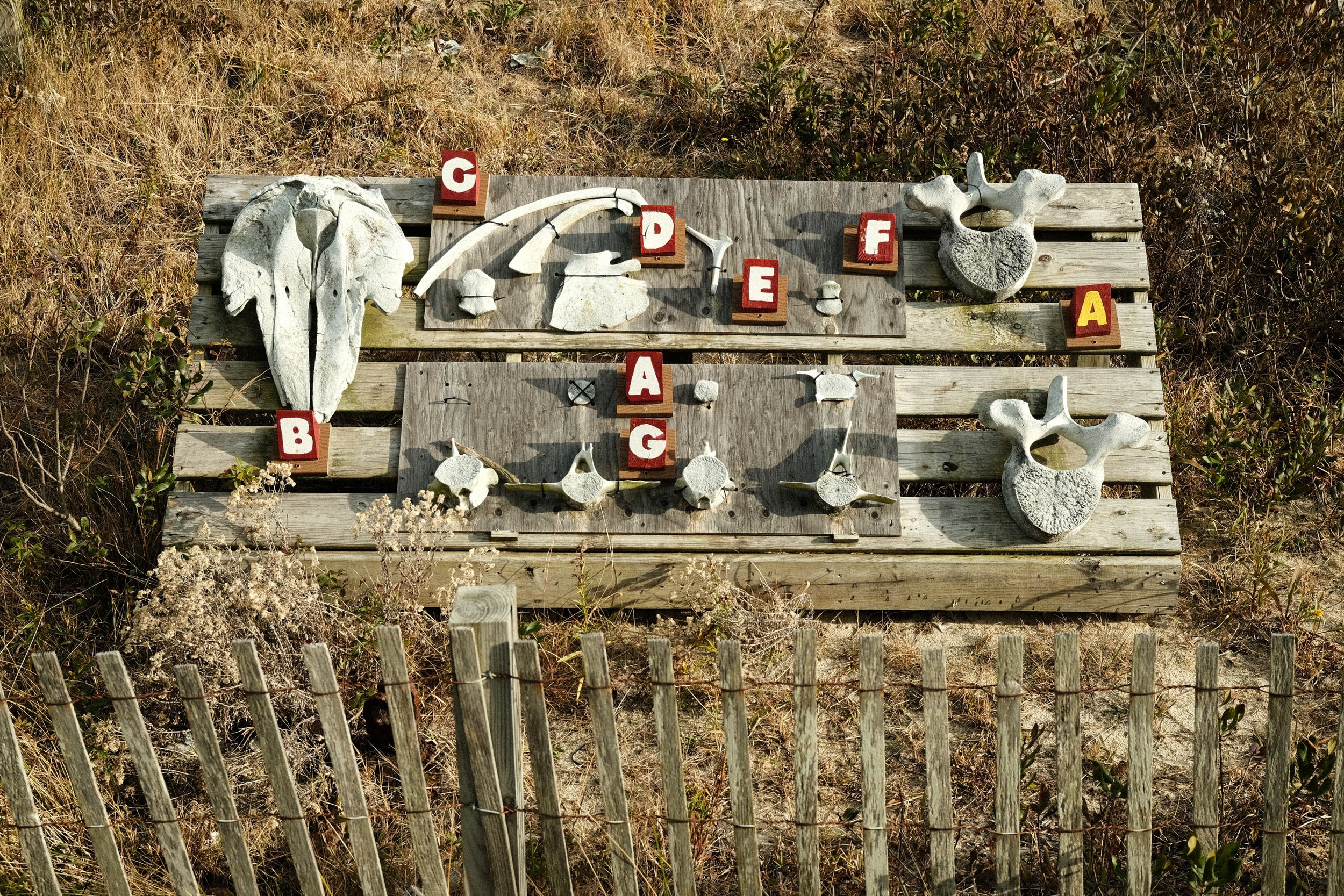The six full-time rangers of the Maryland island’s state park wrangle a hell of a lot — 85 horses, 2 million tourists, and innumerable moments of magic.
Writing by Mickie Meinhardt | Photos by Gunner Hughes
If you take Maryland Route 611 south from its outset near Ocean City as it winds eight or so miles past a few small farms, a handful of developments, the regional airport, and the campground-cum-amusement park Sun Outdoors Frontier Town, you’ll eventually round eastbound to a beautiful stretch of sky and road yearning up over a bridge, the Verrazano, that gives a soul-filling view: the whole of Assateague Island, reaching long and low along the horizon line between glittering stripes of ocean and bay. The famed barrier island is barely above sea level; creamy pillow tops of dunes are the high points, the scrubby gothic bay pines veritable skyscrapers over the emerald marsh fingering out into the bay. If the heavens have smiled and it’s a glassy day, the slick bay and cool sky will become a seamless mirrored sheet of blue-gray on both sides — the horizon completely vanished, giving the otherworldly feeling of being suspended in space, the island ahead the only visible anchor to the world. If you’re very lucky, you’ll see what many hope to: the island’s famous wild ponies, biding time as they do, stoic specks amidst the vista.
As you swan slowly down the bridge to the causeway that leads to the state and national parks, life will make itself known: egrets, pelicans, ducks, ospreys, turtles. In the background, a Maryland state park ranger will be keeping an eye on you and the wildlife and everything in between, doing their best to keep the peace between human curiosity and island idyll.
The ranger will nudge you onward; there is so much more to see. Drive straight ahead to the Maryland state park’s daily use lot (put some money in the honor box for the privilege) and make your way over the dunes. At the top: ocean to the eye’s end, and 37 miles of absolutely pristine beach, one of the largest stretches of undeveloped, protected, yet publicly accessible beaches on the East Coast. There’s a thrum of unseen energy, and ranger-made signs everywhere alert you to what you might see: whales, dolphins, turtles, and, of course, horses. Whether you come in the hot height of summer, the golden-hour fall, the still and steely winter, or the tender and bright spring, it’s always a different kind of breathtaking, a place that exudes a palpable and silencing magic — the very definition of awe-inspiring. Which is why those rangers are so dedicated and so important. They ensure that anyone who visits the island, one-timers or forever devotees, can always have that possibility: of encountering, however briefly, something divine.
Though the origin of the wild horses on Assateague Island is unknown, they are one of the many features that pull in tourists every year. One of the park rangers’ many jobs is to keep visitors safe from the horses — who may bite or kick those who come too close — and vice versa.
We don’t like to think of the outdoors as a kept thing. But behind every publicly accessible park in the world is a group of state or federal employees maintaining that natural beauty. And at Assateague’s state park, that group is a small but mighty force handling a whole lot of actual nature and human nature.
I am just one of millions of people who love Assateague. The island, which buffers the Eastern Shore of Maryland and Virginia from the Atlantic, sees upwards of 2.2 million annual visitors and counting across its three parks. It was the 33rd-most-visited park in the country in 2021, according to the National Park Service, ahead of Mount Rushmore and Arches. Assateague State Park, managed by the state of Maryland, occupies just two of the 37 miles of the island, with Assateague Island National Seashore to the north and south of the state park and Chincoteague National Wildlife Refuge at the far southern end in Virginia. Even with this smaller area, Assateague State Park sees a significant number of the island's visitors: 2,145,695 in 2021. Which is where the rangers come in.
They’re a small but constant presence on the island. As an avid surfer of Assateague State Park’s beaches, I had witnessed them directing traffic, monitoring horses, and checking the beach, and eventually began to wonder what exactly it took to manage Assateague. Over the course of a few weeks in November 2021, I spoke with the six full-time Assateague State Park rangers about what their work entails. Horses that act like bears, people that act like idiots, hurricanes, heaving numbers of post-COVID recent outdoorsmen — turns out, it takes a hell of a lot.
In a park where visitors can surf, swim, fish, kayak, camp, cook out, parasail, windsurf, run, walk, bike, beachcomb, visit a nature center, or attend events, the rangers’ spectrum of work is vast. They cover everything from beach and campground patrol to opening up and running concessions, training lifeguards, working the ranger station and camper check-in, helping out said campers when they get in any kind of pickle, patrolling the causeway for horse-induced traffic jams, rescuing wounded wildlife, educating in schools and outside programs, handling general office management, and managing the many visitors. Some state rangers are EMT trained, others are trained in wildfire fighting.
Assateague Lead Ranger Chris Gleason-Smuck
“It’s all hands on deck here,” says ranger Pat Marshall, the park supervisor. “We hire you for a focus, but everyone pitches in on everything. That’s what surprises people about the job. They think they’re getting into it for the people or the wildlife, but there’s a lot more to it.”
As I interview Marshall, he drives us in loops around the 342 empty Assateague State Park campsites in a pickup truck. It’s a week before Thanksgiving 2021 and not too cold yet, low 50s, and we see some dog walkers, runners, and bikers, plus a band of horses ignoring it all from some trees along the roadway. Though the park has been closed to campers since the beginning of November, the off season can be vibrant, with plenty of people happy to take advantage of the amenities sans crowds. The rangers’ days are quieter but no less demanding, and every one is different — weather, visitors, and wildlife can all throw plans awry. There’s always a fire to put out, and sometimes literal ones at a poorly attended campsite bonfire.
Right now Marshall is focusing on updates to the campsite picnic tables, which are being fitted with much-needed pony-proof food storage boxes (campers who’ve seen them are really excited, he says). He’s also looking to staff the lifeguards for the following summer; each full-time ranger has an area of oversight, and his is beach patrol. I had mostly thought of park rangers as a cross between Smokey Bear, teaching about wildlife, and the Central Park Rangers from “Elf,” riding around on horseback and keeping the peace. These preconceptions I wisely kept to myself.
“I did everything: EMT, roofing, chimney sweeping. I wanted to be a firefighter, but I ended up here. I had a job here in high school, and I enjoyed the work, being where people spend their leisure time. The job is so varied. It’s part of what I love about it. And that my work has meaning. I’m making a positive difference.”
— Park Supervisor Patrick Marshall, from Newark, Maryland. 15 years in parks, 10 years as an Assateague State Park ranger
Marshall says the work is deeply rewarding but challenging, “especially working with the public.” This is a sentiment I hear echoed by all the other rangers. It’s wonderful, it’s a lot, and they do it all for the people. Even the difficult ones.
Assateague lead ranger Chris Gleason-Smuck put it simply: “We protect the resource from the people, the people from the resource, and sometimes people from people.”
Many of the visitors are repeats: campers who’ve been coming for decades to stake out the same site in the same month with friends originally made on the island, or who make it a point to drive over from Ocean City during annual vacations. The longer-tenured rangers know these visitors, have seen them come back year after year, and take pride in the fact that they provide a place where those intimate bonds — with others and with the island — are forged. Though the island is famous for its wild horses, for those who fall in love with it, the horses become background characters to the bigger experience; part of the magic, but hardly the whole.
No one can deny that Assateague owes its fame to the horses. Since Marguerite Henry published her beloved children’s book Misty of Chincoteague in 1947, people have been traveling from all over to see Assateague’s famous wild herds, among the few remaining in the U.S. Technically, there are two herds on the island, separated by the Maryland-Virginia line; the Maryland herd has 85 horses and is managed jointly by the national and state parks, while the Virginia herd has 150 horses and is owned and managed by the Chincoteague Volunteer Fire Company. The horses’ origin remains unknown, though there are many competing theories: equine refugees from a shipwrecked Spanish galleon; farm runaways; abandoned livestock. In appearance they’re somewhere between mangy and cute, and quite photogenic. But in demeanor they are very far from their domesticated brethren.
“The ponies are big trash pandas. Like bears, but friendly-looking,” laughs park Assistant Manager Meghan Rhode. Almost anyone who has spent time on Assateague has a story of being run down by a horse for their sandwich or bag of chips, myself included. It sounds funny, and is somewhat in retrospect, but in the moment it’s fully terrifying. The rangers’ primary problem is preventing that by convincing people that these horses are wild.
“A big portion of our clientele grew up on farms and have been around horses — they love to tell you that. It’s harder to convince them that this is a different situation,” says Rhode. Sure, a domestic horse will bite or kick, but not in a territorial, attacking way. “They’re accustomed to their own space, pushing other people and horses around. … There are stallions here who are willing to battle pretty hard for territory, for food, for mares. That’s one of my biggest problems, getting people to stand up and back away from the horse.”
“I worked on farms growing up, and wanted to be a zoologist. My adviser said, ‘You and everyone else!’ So I ended up at Pocomoke River State Park as a volunteer working on Scales & Tales [educational program]. But I was not really into reptiles or birds at all — until I held a screech owl. I thought, ‘Well, this is pretty cool.’ Now I run the program for Assateague.”
— Assateague State Park Assistant Manager Meghan Rhode, from St. Mary’s County, Maryland. 19 years in parks, 13 years as an Assateague State Park ranger
“Please, please, say to be safe around the horses,” begs Angela Baldwin, the park manager and head honcho, when we speak in her office. It’s a fair ask. All over the island signs read: DO NOT FEED THE HORSES. KEEP YOUR DISTANCE — HORSES BITE AND KICK. But rarely do people listen. Tourists are constantly creeping too close to wary horses for a photo, or leaning out from a car to try to pet or offer food to one grazing. It’s all dangerous, but the feeding even more so because it attracts the horses to the road; inevitably, one is occasionally hit by a car. (Though they more often simply stand in the center of the two-lane road, blocking traffic for miles.)
“I feel like the horses view us more like a buffet,” Rhode says. “I always try to stress to people, ‘Your safety is not worth the cost of a loaf of bread.’ Because we’ve had that. The horse comes up, grabs a loaf of bread, someone tries to grab it back and they get bit or kicked.”
“I kind of got the reputation as the ‘pony ranger,’” says Kirby Brown sheepishly when I ask him his specialty. The newly promoted full-time ranger got his start babysitting the causeway and had noted that the same band of horses often hung around the State Park Day Use lot. So he decided to learn who they were.
“Sarah’s Sweettea is the lead stallion of the group; Finn Radar is the young one. His mom is Gokey, or Gokey Gogo Bones, Sarah’s sister. Then there’s Lauren’s Laughter, and a few that migrate through: [sisters] April Star and Patricia Irene. A band is usually one stallion and the rest, mares. The stallions fight over the bands.” As Brown gets going, his face lights up, the story overtaking him. He tells me that the band used to have another stallion named Yankee, but Sarah’s Sweettea kicked him out. He occasionally spots Yankee on the north part of the beach by himself.
“You see him look off in the distance from the beach where his old band is hanging out, but he can’t come over because he’ll get chased off. Recently, I’ve seen Finn, because he’s a young stallion, kicking Sarah’s Sweettea out here and there and trying to take over. It’s almost like a soap opera.”
Visitors eat this Assateague horse lore up. Why wouldn’t they? There’s nothing quite like it anywhere in the world.
“I love telling people about it. It enhances their experience,” Brown says. “I kind of put on a show; with environmental education, you have to make the topic actually interesting, otherwise people can just read it in a book. You have to sell it, especially to children.”
“This is what I grew up doing. I was always the one kicking over logs and seeing what was underneath, collecting every leaf to see what tree it came from. At some point when I showed off what I’d figured out, and saw how people were excited to know what I know, being able to share that passion was the start. And I never got tired of it.”
— Ranger Kirby Brown, from Charles County, Maryland. Six years in parks, three years at Assateague, first year as a full-time Assateague ranger
I ask Brown who his favorite horse is; he knows every one in the herd.
“[Favorite is] a strong word, because most of the time I’m trying to get them to stop eating someone’s food or pulling trash out of the dumpster,” he laughs. But if he had to pick, it would be 2-year-old Finn. “One playful thing foals do is tug on other horses’ manes. Well, Finn never grew out of that. So now as a full-grown horse, he’s bigger and pulling with all his strength. So all the horses in his band have short manes. I often get asked, ‘What happened, why doesn’t that horse have a long mane, did someone shave it?’ Nope. Basically, the young one pulled everyone’s hair out.”
“We get people from all over the world. They want to learn about the environment and the island. It’s great, even if it’s just telling them where to fish or surf,” says Bill Yates during our conversation in the shuttered ranger office. Yates has been working in national and state parks on and off for 40 years. He’s seen a lot of people, and the ones who come to Assateague, he says, are “truly special.”
“Really 75 percent of what we do is dealing with people,” says park Manager Angela Baldwin. Much of rangers’ environmental work is done in partnership with various Department of Natural Resources divisions: Wildlife, Fisheries, Forestry. All things related to visitors are up to them; the bulk of the job is educating guests about the wildlife, the park history, and what is and isn’t safe to do — enhancing the Assateague experience with knowledge. Every ranger says that is their favorite part, and that the visitors are the reason they do what they do.
“This visit is a memory people will hold for their entire life. If I get the opportunity to make that a little more memorable and special, I take pride in that,” says Brown.
“I was the kid running around catching butterflies before butterfly nets were sold in stores. I studied industrial arts education and liked teaching, but public schools were difficult, so I got a degree in fish and wildlife management. My ideal job was marine biologist. My first seasonal ranger job was as a fee collector [at a national park]. You do it for three months — then the snow comes!”
— Ranger Bill Yates, from Maryland. 40 years in parks, 14 years as an Assateague State Park ranger
The rangers also teach off the island in schools all over the area and train others to do the same: a rotating crew of seasonal rangers, plus partners at the Maryland Conservation Corps (an offshoot of AmeriCorps, where several of the rangers started). The heart of it all is the Scales & Tales program, where educators bring snakes and birds of prey to classrooms. I vividly remember their visits to my own elementary school classrooms, letting them slide a boa constrictor over my shoulders or have an owl perch on my gloved hand. The pure awe in being entrusted with a living, powerful thing was physical. For some kids, that might be their very first experience with a wild animal.
But the public often doesn’t make things easy. They can be gracious and grateful, but like anyone on vacation, they can also be entitled, demanding, and disinclined to follow rules. This leads to everything from lost children and near-drownings, to wildlife bites and stings, to guests being thrown out for disorderly conduct.
“You can come to the park for whatever is going to give you a positive experience, but you still need to do it the right way,” Baldwin says. “It’s more critical now, because people are coming out for selfies and social media opportunities and without a lot of knowledge. They’ve seen other people post photos with horses and don’t really understand what the situation is with a wild horse. It’s a challenge — how do we help them enjoy themselves and keep them safe?”
That goes for the island, too.
The attempts to strike a balance between “have fun” and “be safe” often make the rangers seem like parents to the visitors, which isn’t a far-off metaphor. But it’s all in greater service. They’re helping raise more responsible outdoor enthusiasts, so places like Assateague get to be fully enjoyed and remain the paradisial escapes they are.
Each ranger has their own story behind their devotion to this place. Kirby Brown speaks to the uniqueness of the park: “It means you’re a part of what makes the state special. We’re the only [oceanfront] park in the state. Maryland is often referred to as ‘Little America’ because you go out west and you’re in the Appalachians, mountains, and then you hit the east and you’re at the beach. That’s us.”
“My wife and I had just met and started dating when I took a seasonal position at Assateague,” says park Supervisor Patrick Marshall. “Our relationship and my career mirrored each other as both slowly progressed a step at a time, with me promoting and us going from dating to married to starting a family. Finally graduating park ranger school felt like a culmination of a five- to six-year personal and professional journey with all the twists and turns, so it’s tough to describe just how much that meant to both of us and how proud I felt.”
“We went on camping trips as a family in Maryland — Swallow Falls, Herrington Manor — and that helped instill stewardship of the land and protecting the resources in me at a young age. I was in scouts, up to Eagle Scout. I spent some time writing environmental legislation for the Library of Congress [as an intern] but really wanted to be outside and do field work — learning new ecosystems, the wildlife.”
— Lead ranger Chris Gleason-Smuck, Baltimore City, Maryland. 10 years in parks, two years as an Assateague State Park ranger
Baldwin speaks rapturously about the times “when you’re more or less by yourself — the experience can be amazing. It’s just different when there are people around.”
It is. The wildlife comes out to play when people don’t. A few times walking up the deserted boardwalk to the beach, I’ve scared out a rabbit hiding underneath it, and once a fox. And there was the time I changed out of my wetsuit alone in the parking lot and caught a mare watching me from the pines. During the initial COVID lockdown in March and May of 2020, when Assateague was closed, Baldwin was one of the few occasionally driving out to the island and says it was so alive.
“I’d never seen so many bald eagles on the beach. There were oystercatchers nesting in a place they never had. You would come across the dune and it would be teeming with more wildlife than you normally see. It was pretty amazing.”
Gleason-Smuck echoes that. “Being able to have those moments with the wildlife, like last winter, when I was fortunate enough to see a whale. Or when you see a seal come up on the beach and rest before diving back in the water. That keeps me in.”
I have a mental cache of my own “magic moments” on Assateague, times when it really does feel like somewhere heavenly and unreal. Most are when I’m in the water, usually between 7 and 9 in the morning, when the wind is low from the west and just right for clean waves, there aren’t many clouds, and the just-risen sun paints the horizon in pastels and makes the ocean look like quicksilver. On the best of mornings, it feels like everyone is basking in Assateague’s beauty; there will be dolphins and pelicans, the other surfers remarking on it all in hushed awe. I won’t forget a fiery and fierce November sunset that turned the dunes red-gold, or a late-October day when the ocean was as clear and green as the Caribbean and I could see straight to the bottom, my board slicing over water that was like crystalline jade glass.
I mention these moments to the rangers, and thank them. Ultimately, I get to have those experiences because they do such incredible work protecting the island.
“There is a lot about the island that’s magical,” Assistant Manager Meghan Rhode agrees, smiling softly. “Walking the beach after a storm can be fantastic. Seeing all the different shells and things that wash up, like a live starfish. I’ve seen a manta ray jump out of the water and splash, which was incredible. We don’t see them very often here.” She cites fall sunsets, too: “On the causeway, they create a beautiful palette across the marsh, all these little pockets that change color as you drive, pink to purple to blue.”
As a fellow surfer, Marshall’s favorite times mimic mine: “I love all the quiet moments, especially in the fall and winter when you feel like you have the island almost to yourself. The most magical ones are usually those offshore-wind mornings when you wake up early and can luck into a little barrel and a couple of turns before work.”
Yates notes how close we came to not having all this; Assateague was almost developed into a resort town in the 1950s, before the Ash Wednesday Storm of 1962 deterred the developers and they sold the land to the federal government. The Maryland state park, however, had been a caveat; the developers' plans had included two miles set aside for public use, and thankfully the stipulation remained. Yates whistles thinking about that. “There aren’t many places where you get 37 miles of undeveloped, pristine beach. That’s very, very special.”
“One thing that always stops me in my tracks is watching the pelicans, the brown ones, specifically,” Brown says. “They all fly in unison, and then they’ll dip down and ride the crests of the waves as they fly through. And it looks effortless. Their wings don’t even move. They just ride the crest until the wave goes by and they come back up and find the next and ride it through, and seeing that flow, how it just happens — it’s magical. Everything suddenly, perfectly fits together. Nothing is forced.”
We both go quiet. He thinks.
“It’s something you don’t see with people. You gotta work at all this,” he waves his hand, implying life. “But out here, it just happens. That always gives me pause.”
Header Image: Lead ranger Chris Gleason-Smuck, who’s been at Assateague for two years, stands in front of a map marking the state park’s campsites.
Mickie Meinhardt is a writer and the owner of The Buzzed Word bookstore, natural wine store, and wine bar in Ocean City, Maryland, where she champions diverse voices and community. She was formerly the Events Director for Guernica magazine in New York City and holds an MFA in Creative Writing from The New School. Her work has appeared in Guernica, The Bitter Southerner, Eater, The Seventh Wave, and elsewhere, and currently in her newsletter, Wax On. Most days, you can find her surfing or pouring wine at her bar, and online @mickiemyheart.
Gunner Hughes is a photographer on the run. Maryland born and bred — with a stint in Florida and a hiatus in New York City — he is now based on the road somewhere south of the Mason-Dixon.



